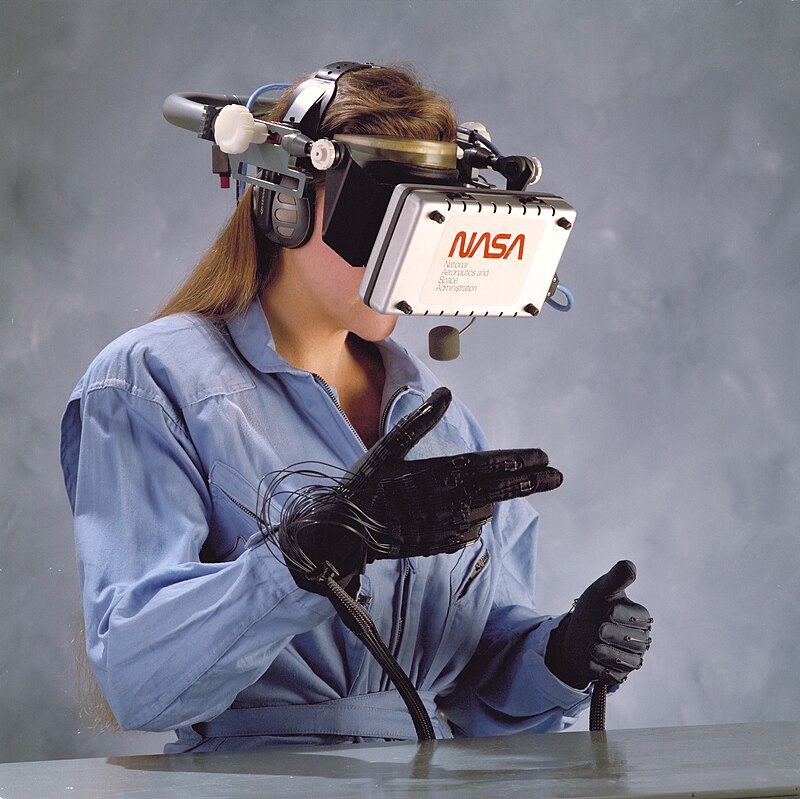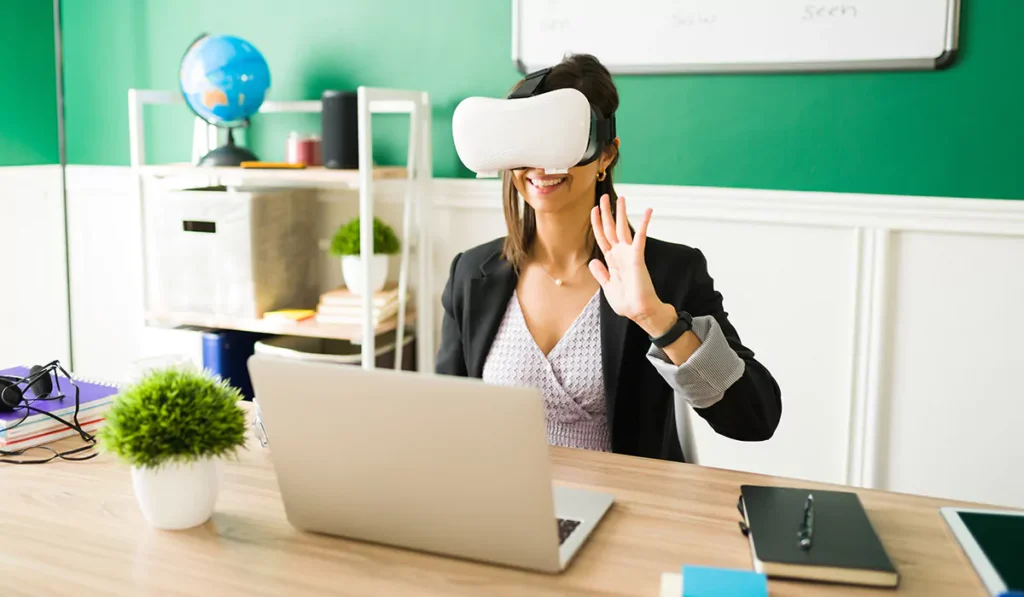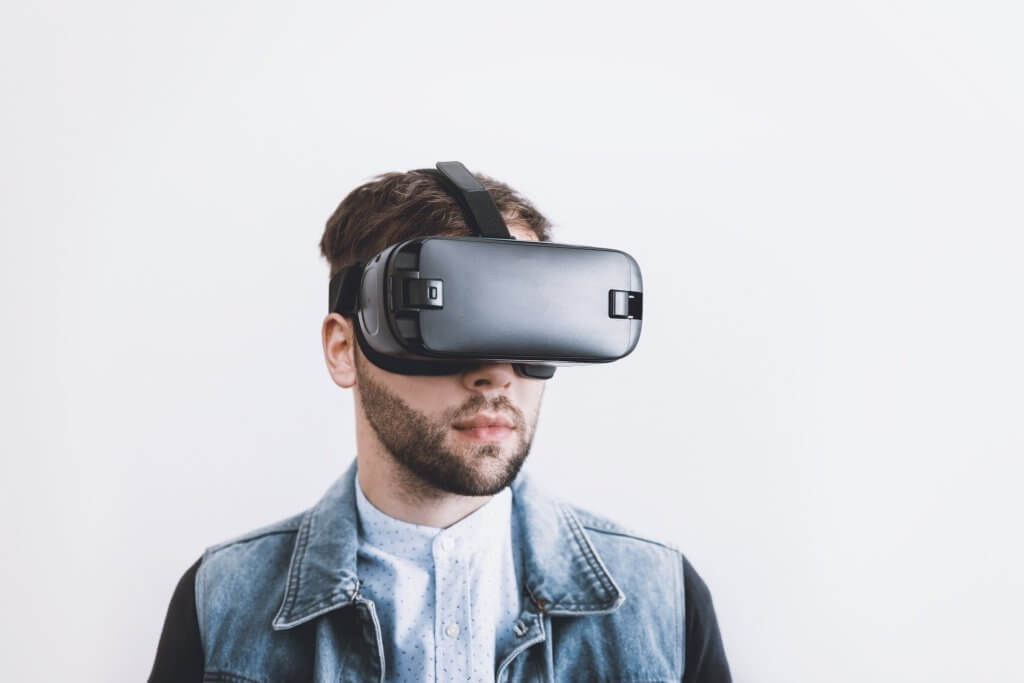Virtual reality (VR) technology is advancing at an exponential rate as we head toward the end of 2024. Virtual reality tech has several applications, including video games, training for the medical field, and engineering simulations.
With more and more sectors adopting the technology, VR’s potential is really starting to take shape. This blog post examines the emerging VR trends that will impact the industry as a whole in the future years.
5 Trends in VR Development That Emerged in 2024 and Will Continue to Exist
There are always going to be new software and hardware offerings. What VR development trends might we anticipate for this year as technology advances?
These are them:
1. Greater Augmentation of Other Technologies

Source: en.wikipedia.org
Integrating VR with other forms of technology is a new trend in virtual reality. This encompasses machine learning and artificial intelligence (AI). Businesses can enhance the precision and authenticity of VR experiences using AI and machine learning, which in exchange makes them more compelling and interesting for consumers.
Applications for virtual reality that use machine learning and artificial intelligence will likely increase. Machine learning may be used by businesses to increase the precision of VR engineering simulation attempts. Engineers can now test and improve designs more easily thanks to this invention.
This particular scenario is shown by the collaboration between Volkswagen and HTC. Volkswagen employs the system in conjunction with HTC’s VIVE Pro Eye headset, which combines eye-tracking technology to enable more intuitive and natural VR interactions. The training simulations replicate actual circumstances that Volkswagen staff members can face, such as putting together components or resolving problems on the production line.
2. Greater Attention Is Paid to Accessibility
Accessibility is one of VR’s main drawbacks. VR headsets may be pricey, large, and unpleasant for long amounts of time. Further, some people may not be able to utilize VR technology at all, such as those with impairments or restricted mobility. Thankfully, developers are attempting to open up VR to a wider audience of consumers.
We may anticipate a greater emphasis on accessibility in VR growth through 2024 and beyond. Companies are already attempting to create headsets that are lighter and more comfortable as well as to provide software that is more accessible to those with impairments. In addition, a lot of developers are focused on developing VR experiences that are more open-minded, taking a wider variety of backgrounds and skills into account.
Microsoft’s SeeingVR, a project by Microsoft Research that attempts to make VR more readily available to those with limited vision or blindness, is an illustration of an effective VR accessibility endeavor. Additionally, Oculus unveiled its new Fit Pack for the Quest 2 VR headset in December 2020. It features two replaceable facial interfaces that let users select the fit that feels the most comfortable.
3. Expanding Social Virtual Reality
Another new trend that is anticipated to have an impact on the business in the years to come is social VR. When we talk about social VR, we mean when users engage in interpersonal contact within virtual settings. Social VR is just face-to-face social contact in a virtual environment. Through this experience, it is possible to connect with individuals all around the world in novel and interesting ways.
These encounters vary from unstructured social gatherings like concerts or seminars to more formal social activities. We anticipate social VR’s potential for instruction, training, and entertainment as it becomes popular.
Facebook Horizon, which debuted publicly for beta in 2020, is the most resounding illustration of social VR. A social VR application called Facebook Horizon enables users to build virtual worlds and communicate with one another in virtual reality.
4. The Prospects for VR Gaming

Source: program-ace.com
One of the main engines of the VR business has always been gaming. If you enjoy playing video games, you are likely familiar with the exhilarating rush that comes from doing so in a setting that feels just like reality. A realistic experience when playing games is what many developers are working toward right now!
More VR games may use AI and machine learning, which makes the virtual worlds more lifelike and interesting. Sophisticated sensory feedback systems may also be developed, enabling players to interact with the virtual environment in novel and fascinating ways.
Gaming includes sports and eSports betting, as well as casino gambling. Virtual reality has found its place there too. For instance, virtual online casinos have been developed using VR, where players may take part in tournaments or just play a particular game while assuming their own avatar using specialized headsets like the Oculus Quest 2 or HTC VIVE.
There are virtual reality betting sites that have already given it the appearance of having the power to completely transform the industry. Some of these platforms, including those evaluated at Bookmaker-Expert.com, who presented at the just-concluded SBC Summit Barcelona, offer a comprehensive 360-degree live game streaming feel that gives devotees the best seats in the house and gives them new opportunities to interact with the game in real-time, involving straightforward in-play betting capacities, competitions, and the opportunity to buy exclusive goods and NFTs.
Along with these developments, more multi-platform VR gaming experiences are to come, enabling players to team up regardless of their gear.
5. Innovations in Hardware
The technology for VR is also developing quickly, with new gadgets and accessories being created all the time. Lightweight and more ergonomic headsets, more precise motion detection, and more realistic haptic feedback are a few of the hardware advancements to be expected in 2024.
Brain-computer interfaces (BCIs) are one potential breakthrough in VR hardware. Users of BCIs may direct virtual reality sessions with their thoughts. As a result, controllers or other types of input devices are no longer required. It is possible that BCIs are still in their infancy. They might, however, completely transform the VR market in the upcoming years.
The Development of Virtual Reality at This Time
Popular culture has consistently included virtual reality. Virtual reality has been portrayed in films like Ironman and Star Trek. However, VR is not simply used in movies, and in the upcoming years, it will become more prevalent.
There are various uses for VR technology, from entertainment and gaming to instruction and training. VR may be used, for instance, to simulate medical operations in the medical sector. VR enables medical professionals to hone their abilities in a secure setting. It may also be used in the educational sector to develop immersive learning experiences, including virtual field excursions or historical reenactments.
The capacity of VR to instill a feeling of presence, giving users the impression that they are truly in the area, is one of its key advantages. Because of this, VR encounters are more interesting and memorable than more conventional forms of media like text or video.
The current virtual reality growth is one that has experienced rapid breakthroughs and innovations as a result of this important benefit. VR is influencing more people than just companies and organizations. It now reaches customers directly. A significant increase in VR software and hardware products has been seen during the last several years. VR is becoming more and more available to both consumers and companies.

Source: arpost.co
Conclusion
There are plenty of reasons to be hopeful about the possibilities of virtual reality advancements in the future. We can anticipate seeing even more cutting-edge and captivating VR experiences as the technology develops, in everything from education to healthcare to gaming. Although there are still obstacles to be solved, such as those related to user comfort and accessibility, the development in these domains is encouraging.
We do not need to sit and wait for the future of VR, it is happening already all around us!



